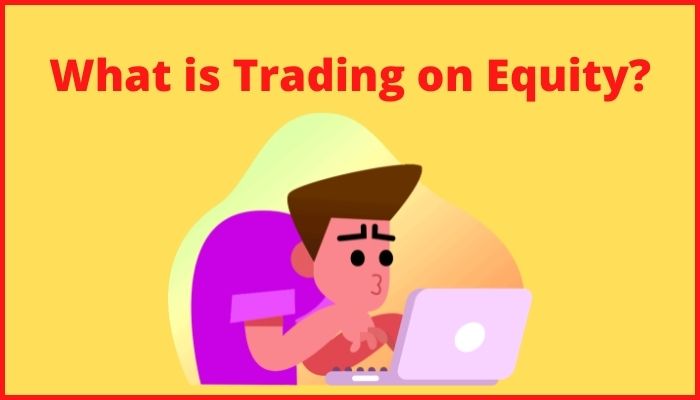Corporations use a variety of financial tactics to boost shareholder profits. Trading on equity is one such technique, in which businesses obtain new debt in the nature of debentures, preferred shares, bonds, or loans. Let’s Discuss what is trading on equity? and related terms & other clarifications regarding it.
Table of Contents
What is Trading on equity?
Trading on equity is a monetary method in which a firm’s debt generates benefit for its shareholders. When an entity takes on additional debt in the form of securities, loans, bonds, or preferential share. It is known as trading on equity.
The corporation then invests this money in assets that will generate higher returns than the new debt’s interest. Trading on equity, on the other hand, is referred to as financial leverage.
It is viewed as a positive if it assists the corporation in generating profit and provides a higher return on investment for the stakeholders. This is normally done to increase earnings per share.
Basis of Trading on equity
The term “trading on equity” comes from the fact that the firm receives its loan amount from lenders depending on its equity value. Firms generally raise money at low interest rates by leveraging their equity.

Types of Trading on equity
There are two types :
Trading on thin equity
The term “trading on thin equity” refers to borrowing a huge amount compared to the business’s equity.
Trading on thick equity
The term “trading on thick equity” refers to the company whose total borrowing is the minimum amount.
Now let’s discuss the advantages and disadvantages of it.
Advantages and Disadvantages
These are the some pros and cons of it:
Pros of meaning of trading on equity
The major Pros are:
- Growing revenue
By borrowing the money required, the organization expands its income opportunities by adding new resources.
- Tax benefit
The interest paid on the loan money is tax deductible. As an effect, the borrowing entity would pay a lower tax rate. As a general rule, the borrower’s overall expense is reduced as a consequence of the new debt.
Cons of trading on equity
It has its own collection of risks.
- If the company is unable to pay off the interest burden, it will undergo more losses.
- You should be aware that these borrowings will put a company in a high-risk condition if it relies on the borrowed funds to run its services.
- An unanticipated spike in interest levels will result in damages because the firm ‘s monetary cost of interest would expand.
So, although it has the capacity to enhance returns, it also comes with a significant threat of failure.

What are the Situations to make it positive for a company?
In the corresponding scenarios trading on equity is expected to be successful –
- When a well organisation uses such methods of fundraising
- The essence of the firm ‘s operation is not speculative
- revenues and revenue are consistent and predictable
Any of the above reasons, public utility companies often use this funding strategy. These businesses have enough cash on hand to make large-scale leveraging possible.
Which companies like to choose trading on equity ?
Since it will lead to a wide range of income, it has an effect on stock options by raising their recognized value. Option investors are the ones who are most willing to pocket their options as income rises. The possibilities of the holder receiving a higher return are higher since the income is n’t fixed.
As a result, executives are more willing to adopt this option than owners. Executives may raise the value of their stock options by following this procedure. A family-run company, on the other side, places a high value on financial stability, so it is doubtful that they will take this pathway.
Metrics to measure the effects
- Capital Gearing Ratio = (Preference capital + Debentures) / Shareholder’s equity
- Degree of financial borrowing = % change in EPS / % change in EBIT
The capital gearing ratio can be used to determine how much a firm’s capitalization is reliant on its equity. One can understand how EPS can fluctuate in response to changes in EBIT by looking at the degree of financial leverage.
Example of Trade equity meaning
XYZ Company is looking for funding to expand. The company’s existing capital structure includes INR 20 lakhs in equity capital (INR 10 each share). This extension would cost another INR 20 lakhs to fund. For this reason, XYZ company’s executives are exploring the below possibilities . –
- Issuance of ordinary stocks worth INR 20 lakhs.
- Issuance of ordinary stocks worth INR 10 lakhs and the rest by procurement of 5% debt.
- total sum by procurement of 6% debt.
- Issuance of common shares worth INR 10 lakhs and the rest by issuing 5% preference stocks.
The firm is expected to report an EBIT of Rs.2400000 from its expansion venture.
Balance sheet
| XYZ Company (Number in Rupees expect number of shareholders) |
| ITEM | Scenario 1 | Scenario 2 | Scenario 3 | Scenario 4 |
| EBIT | 2,400,000 | 2,400,000 | 2,400,000 | 2,400,000 |
| Less: Interest | Nil | 20,000 | 44,000 | Nil |
| EBT | 2,400,000 | 1,180,000 | 2,356,000 | 2,400,000 |
| Less: Taxes @ 50% | 1,200,000 | 1,140,000 | 1,178,000 | 1,200,000 |
| Earnings After Taxes (EAT) | 1,200,000 | 1,140,000 | 1,178,000 | 1,200,000 |
| Less: Dividend to preference shareholders | Nil | Nil | Nil | 100,000 |
| Earnings available to shareholders | 1,200,000 | 1,140,000 | 1,178,000 | 1,100,000 |
| Number of shareholders | 90,000 | 70,000 | 45,000 | 70,000 |
| EPS | 13.33 | 16.28 | 26.17 | 15.71 |
XYZ company will be able to increase shareholder income by going for a pure debt strategy, as shown in the above equation.

Trading on Equity vs Equity Trading
The phrases “trading on shares” and “equity trading” are often confusing for many people. These two words, nevertheless, represent completely opposite meanings. Buying and selling securities is what equity trading is all about, while trading on equity is an investment method to increase shareholder income.
Equity trading is carried out and executed by company executives. Whereas, equity trading may be carried out by any person or organisation. By trading on equity, Executives get profit from the gap among returns on investment and interest on debts.
On the other side, investors who engage in offline or online equity trading try to get the profit from stock price fluctuations by purchasing shares at a discount and selling them at a premium.
Conclusion
Trading on equity can be seen as a type of trade-off. A business uses its equity to raise additional funds for the purchase of new resources, which are then used to repay its debt. Hope you can now fully understand it.
This is all from our side regarding what is trading on Equity? Let us know your views about trade equity meaning in the comment section.
Other Interesting blogs related to what is Trading on Equity?
FAQ About Trading on Equity Meaning
Trading on equity is beneficial or not?
It totally depends on the company's financial abilities. You check the example given in this article.
Advantages of trading on equity?
The two major advantages are Growing Revenue & Tax Benefits.
Types of trading on equity?
There are two types of trading on equity, trading on thin equity and trading on thick equity.
trading on equity meaning in hindi?
इक्विटी पर ट्रेडिंग एक मौद्रिक पद्धति है जिसमें एक फर्म का ऋण अपने शेयरधारकों के लिए लाभ उत्पन्न करता है।
Trading on equity is used to increase EPS true or false?
Yes, It is true that Trading on equity is used to increase EPS.

